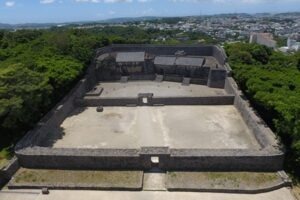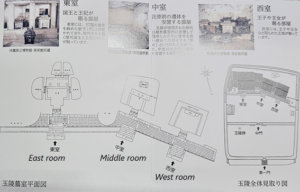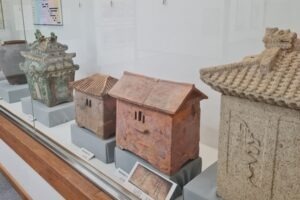My Exploration of Tamaudun: The Royal Mausoleum of Okinawa’s Ryukyu Kingdom
Origins and Purpose

Tamaudun, constructed in 1501, is the royal mausoleum of the Second Shō Dynasty in Okinawa’s Ryukyu Kingdom. Built by King Shō Shin to house his father Shō En’s remains, the mausoleum is located near Shuri Castle in Naha City. The tomb’s name, “Tamaudun”, translates to “jeweled grave”, and may also mean “Hall of Spirits” in Okinawan dialect, referring to its purpose as a resting place for the royal line.
Design and Structure
Tamaudun combines Okinawan and East Asian architectural styles. Modeled after Shuri Castle and carved from limestone, it covers around one hectare and is surrounded by coral limestone walls built in the aikatazumi 1style.
 Inside, a courtyard leads to the three-chambered tomb structure. The central chamber was traditionally used for Senkotsu 2, the Okinawan ritual of “washing bones”, Bones were initially laid out, cleaned, and then placed in urns for interment in either the eastern chamber, for kings and queens, or the western chamber, for other royal family members.
Inside, a courtyard leads to the three-chambered tomb structure. The central chamber was traditionally used for Senkotsu 2, the Okinawan ritual of “washing bones”, Bones were initially laid out, cleaned, and then placed in urns for interment in either the eastern chamber, for kings and queens, or the western chamber, for other royal family members.
This structure draws on burial practices seen across the Ryukyu Islands and parts of Southeast Asia, with symbolic features like protective lion statues (shīsā) and dragon carvings, highlighting the cultural heritage of Okinawa.
Historical and Cultural Significance
The Senkotsu practice reflects the Ryukyu Kingdom’s reverence for ancestors, emphasizing Tamaudun’s role in cultural preservation. The site’s architectural style, rooted in Okinawan and East Asian influences, makes it distinct from other mausoleums. Resembling Shuri Castle, Tamaudun showcases the sovereignty and unique heritage of the Ryukyu royal family.
The Impact of World War II
Tamaudun was severely damaged in World War II. Restoration began postwar, and in 1972 it was designated a National Historical Site. Repair work was completed by 1974, restoring it to its historical state. In 2000, UNESCO awarded it World Heritage status, and in 2018, Tamaudun became Okinawa’s first National Treasure, affirming its historical and cultural importance.
Tamaudun Today

Today, Tamaudun is a heritage site open to the public. Visitors can explore the Tamaudun Hōenkan 3, an exhibition space featuring artifacts and displays on the Ryukyu Kingdom’s history, ensuring Tamaudun’s ongoing role as a cultural bridge between Okinawa’s past and present.
Video
Conclusion
Tamaudun is more than just a mausoleum; it’s a symbol of the Ryukyu royal lineage and Okinawan identity. As I walked on the site, I could feel the weight of history, and the distinctive architecture and burial customs reminded me of the enduring legacy of the Ryukyu Kingdom that continues to resonate today. My visit has deepened my appreciation for Okinawan culture and its remarkable history.
Thank you for joining me on this journey through Tamaudun
Gert
Footnotes:
1 Aikatazumi style; The Aikatazumi style is a traditional Japanese masonry technique. It involves the precise fitting of irregularly shaped stones, often pentagonal and hexagonal, without mortar. This method allows the stones to lock tightly together, creating a stable, interlocking structure.
2 Senkotsu (洗骨); Washing of cremated bones before placing them in a funerary urn (esp. in Okinawa).
3 Hōenkan (宝円館); Treasure (宝, hō) and hall or building (円館, enkan). “Hōenkan” can be interpreted as “Treasure Hall” or “Hall of Treasures.”
Share this article
